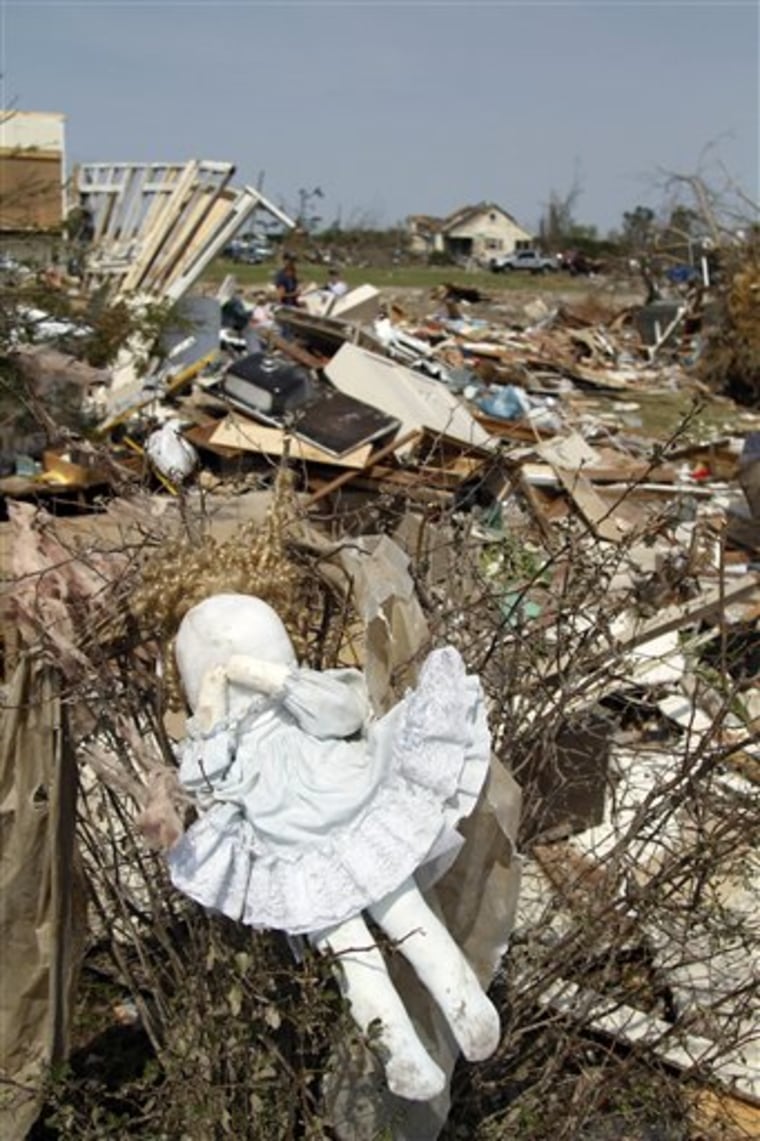The devastation is stunning — homes and lives shattered as the deadliest swarm of twisters in three years battered up to 15 states.
Ultimately, this could turn out to be among the top 10 three-day outbreaks for number of tornadoes, though experts can't be sure until all the reports are sorted, said Greg Carbin of the federal Storm Prediction Center in Norman, Okla.
While tornadoes occur regularly, their power always shocks.
This time it was storms battering their way from Oklahoma to North Carolina, claiming at least 44 lives, almost half of those in North Carolina. It was the deadliest since Feb. 5, 2008, when 57 died in the "Super Tuesday" election day tornadoes in the Southeast. And that was the highest tornado death toll since 76 died in 1985.
"A major storm system like this is going to happen every few years, usually in April or May," said Carbin.
While May is the nation's busiest month for twisters, they surge sharply in April, and most early spring tornadoes strike the Southeast and South Central states.
Indeed, the biggest tornado outbreak on record occurred April 3-4, 1974 when 147 confirmed twisters touched down in 13 states, claiming 310 lives in the United States and 8 in Canada.
For about the past 30 years, the United States has averaged 135 tornadoes in April, the highest number being 266 in 1974, according to Jake Crouch of the National Climatic Data Center in Asheville, N.C.
Many reports likely duplicates
In these latest storms, the National Weather Service is investigating 267 preliminary tornado reports — including 97 in North Carolina on Saturday. But many of those will turn out to be duplicates, Carbin said in a telephone interview
Such a large number of reports has become typical in recent years as more people watch for the storms and call them in. Normally more than half turn out to be duplicates and Carbin estimated that the final count for this series of storms will be around 140.
Teams are out assessing the damage now, but he said it can take several days to more than a week to make a final determination.
In this case, the storm system first developed over the Pacific and intensified when it got to the central Plains on Thursday where the dry western air collided with the warm humid air from the Gulf of Mexico.
From there, the storms developed "pretty much as expected" over Oklahoma, Carbin said. Overnight, the storms merged into a fast-moving front crossing Arkansas and into the Mississippi River Valley, drawing fuel from daytime heating, striking on into Mississippi and Alabama and then into the Appalachians by Saturday morning. Then the storms again strengthened with daytime heat for the third day of tornadoes, hitting North Carolina hardest.
Tornado Alley
It's that intersection of dry and wet air masses that sets up Tornado Alley, the region in the center of the country regularly pummeled by tornadoes.
Overall, from Thursday through Saturday, there were reports of funnel clouds in Kansas, Oklahoma, Texas, Arkansas, Alabama, Illinois, Missouri, Mississippi, Kentucky, Georgia, Louisiana, Maryland, Virginia, North Carolina and South Carolina.
April's reputation as a deadly month was cemented in 1936 when a twister killed 216 people in Mississippi on April 5, and a day later another 203 died in Georgia. And 143 people died in Louisiana and Mississippi April 25, 1908.
Recent years tend to be marked by more tornadoes and fewer deaths, as forecasts have improved, along with communications, allowing people to prepare and also encouraging people to report funnel clouds to authorities.
Unlike tornado outbreaks of the past, the National Weather Service reports that nearly 90 percent of the past weekend's reported storms occurred in areas where tornado warnings were in effect. In central North Carolina, 97 percent of the tornadoes were in areas where warnings had been issued, with an average lead time of almost 26 minutes.
By contrast, before 1950 the use of the term tornado in forecasts was discouraged because of a fear that predicting them would cause panic. The first successful tornado forecast was made by Air Force meteorologists at Tinker Air Force Base in Oklahoma in 1948.
